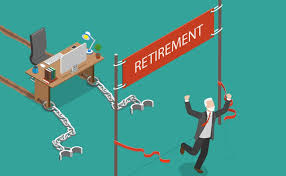Mitigating the Financial Risks of a Forced Retirement

An early retirement is a celebratory event when it happens according to your timeline. But it can also be a financial wrecking ball when you’re forced to retire prematurely — something many Americans experienced during the COVID-19 pandemic.
Indeed, more than 3 million additional workers in the U.S. retired during the pandemic than is typical, according to a Federal Reserve Bank of Saint Louis analysis, which found “a significant number of people who had not planned to retire in 2020 may have retired anyway because of the dangers to their health or due to rising asset values that made retirement feasible.”1
But it’s not just a global health crisis that can induce an early retirement. Injury and illness are among the most common reasons that cause a forced retirement. Some on the cusp of retirement lose their jobs and choose to sit it out for good when their employer downsizes or their skill set becomes obsolete. And others stop working before they intended to care for an ailing loved one.
Indeed, those who are forced into early retirement early need to consider the following potential financial risks:
- Longevity risk
- Health insurance coverage
- Inflation
- Sequence of returns risk
Taking steps to manage these risks as early as possible is a must. For guidance, many turn to a financial professional.
Longevity risk after a forced retirement
Those who stop working before their normal retirement age are far more vulnerable to longevity risk — the likelihood of outliving their assets — because they must stretch their savings out over a greater number of years. They also have fewer working years to contribute to tax-deferred retirement accounts, so they start off with less in the bank.
As a general rule of thumb, financial professionals often recommend a 3 percent or 4 percent withdrawal rate during the first year of retirement. Retirees can then adjust that amount higher annually to keep pace with inflation.
Assuming their investment portfolio earns more than 4 percent on average per year, that withdrawal rate ensures that they will only ever spend their earnings and leave their principal untouched.
Early retirees, who need their savings to last longer, may need to learn to live on less. They may also need to reduce their expenses by downsizing to a cheaper house or simply return to work (even part time) for a few extra years to bolster their retirement nest egg.
Those who have the means can also potentially delay claiming Social Security benefits a few extra years to permanently increase the size of their future Social Security checks — the best way to give yourself a raise during retirement.
Health insurance coverage after a forced retirement
Many early retirees underestimate the potential cost of paying for private health insurance during the years before they become eligible for Medicare, the federal health insurance program covering those age 65 and older, certain younger people with disabilities, and those with end-stage renal disease.
Premiums for private health insurance, even for a few years, can consume an oversized portion of your savings, which could undermine your ability to make ends meet throughout retirement.
Options for coverage include COBRA, a spouse’s insurance, retiree health insurance benefits, the public marketplace, private health insurance, membership-based group health plans, and Medicaid for those with demonstrated financial need.
Long-term care (LTC) insurance coverage, which picks up where Medicare leaves off, can potentially curb future costs related to assisted living and nursing home care. Some hybrid life insurance policies include LTC coverage.
Before buying an LTC insurance policy, retirees should speak with a financial professional to determine whether such coverage is the right fit for their family.
Inflation
The rising cost of goods and services, otherwise known as inflation, is enemy number one for retirees.
When you no longer produce an income, any increase in consumer prices erodes your purchasing power. And the more years you spend in retirement, the bigger that threat becomes.
Historically speaking, inflation rises from 1 percent to 3 percent per year. Assuming 3 percent annual inflation rate, a 55-year-old making $50,000 per year who retires today would need the equivalent of about $91,000 by age 85 to maintain the same standard of living.
Inflation, of course, doesn’t always remain within the federal government’s target range. In early 2022, the Consumer Price Index soared to 7.5 percent, the biggest spike in consumer prices since 1982.
Retirees typically scale back their level of investment risk because they depend on their retirement savings for income and can’t afford a period of prolonged losses. While that may be age appropriate, it is also a risk to become too conservative with their asset allocation.
Sequence of returns risk
New retirees, regardless of when they leave the workforce, must also be mindful of market performance.
Those who retire into a bear market, or experience losses or low returns in the early years of their retirement, are statistically far more likely to outlive their savings than retirees who experience losses later on.
Indeed, while permanent life insurance policies are primarily designed to provide a death benefit to protect the ones you love, they also build cash value as premiums get paid – and you can borrow from your cash value for any purpose.
For example, retirees can use their cash value to pay the bills when the market is down, giving their investment portfolio time to recover.
Another way to offset sequence of returns risk is to create a traditional emergency fund worth at least 12 months of living expenses in a liquid account, such as a savings or money market account, from which retirees can draw an income during periods of market downturns.
Conclusion
It’s one thing to plan for an early retirement, but quite another to be forced out of the workforce prematurely. With careful planning, professional guidance, and tools to mitigate multiple risk factors, however, it may still be possible for early retirees to live the lifestyle they had envisioned.
Provided by Matthew Clayson, courtesy of Massachusetts Mutual Life Insurance Company (MassMutual). CA Insurance License # 0I01304
©2023 Massachusetts Mutual Life Insurance Company, Springfield, MA 01111-0001
MM202611-307408









